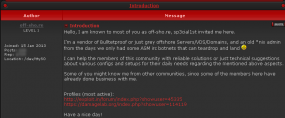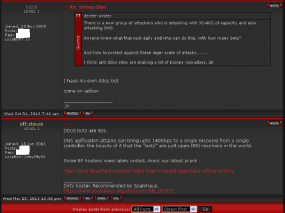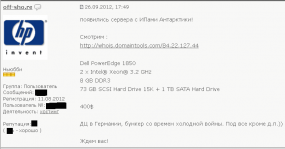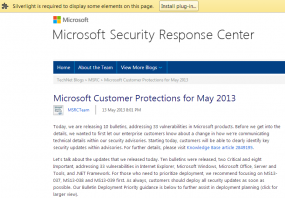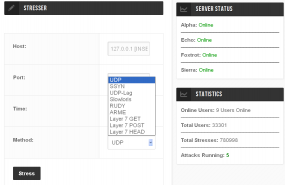On Monday, I profiled asylumbooter.com, one of several increasingly public DDoS-for-hire services posing as Web site “stress testing” services. Today, we’ll look at ragebooter.net, yet another attack service except for one secret feature which sets it apart from the competition: According the site’s proprietor, ragebooter.net includes a hidden backdoor that lets the FBI monitor customer activity.
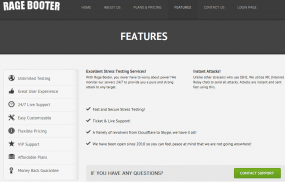
Ddos-for-hire site ragebooter.net
This bizarre story began about a week ago, when I first started trying to learn who was responsible for running RageBooter. In late March, someone hacked and leaked the users table for ragebooter.net. The database showed that the very first user registered on the site picked the username “Justin,” and signed up with the email address “primalpoland@gmail.com.”
That email address is tied to a now-defunct Facebook account for 22-year-old Justin Poland from Memphis, Tenn. Poland’s personal Facebook account used the alias “PRIMALRAGE,” and was connected to a Facebook page for an entity called Rage Productions. Shortly after an interview with KrebsOnSecurity, Poland’s personal Facebook page was deleted, and his name was removed from the Rage Productions page.
Ragebooter.net’s registration records are hidden behind WHOIS privacy protection services. But according to a historic WHOIS lookup at domaintools.com, that veil of secrecy briefly fell away when the site was moved behind Cloudflare.com, a content distribution network that also protects sites against DDoS attacks like the ones Ragebooter and its ilk help to create (as I noted in Monday’s story, some of the biggest targets of booter services are in fact other booter services). For a brief period in Oct. 2012, the WHOIS records showed that ragebooter.net was registered by a Justin Poland in Memphis.
I “friended” Poland on Facebook and said I wanted to interview him. He accepted my request and sent me a chat to ask why I wanted to speak with him. I said I was eager to learn more about his business, and in particular why he thought it was okay to run a DDoS-for-hire service. While we were chatting, I took the liberty of perusing his profile pictures, which included several of a large tattoo he’d had inked across the top of his back — “Primal Rage” in a typeface fashioned after the text used in the Transformers movie series.

Poland is serious about his business.
“Since it is a public service on a public connection to other public servers this is not illegal,” Poland explained, saying that he’d even consulted with an attorney about the legality of his business. When I asked whether launching reflected DNS attacks was okay, Poland said his service merely took advantage of the default settings of some DNS servers.
“Nor is spoofing the sender address [illegal],” he wrote. “If the root user of the server does not want that used they can simple disable recursive DNS. My service is a legal testing service. How individuals use it is at there [sic] own risk and responsibilitys [sic]. I do not advertise this service anywhere nor do I entice or encourage illegal usage of the product. How the user uses it is at their own risk. I provide logs to any legal law enforcement and keep logs for up to 7 days.”
The conversation got interesting when I asked the logical follow-up question: Had the police or federal authorities ever asked for information about his customers?
That was when Poland dropped the bomb, informing me that he was actually working for the FBI.
“I also work for the FBI on Tuesdays at 1pm in memphis, tn,” Poland wrote. “They allow me to continue this business and have full access. The FBI also use the site so that they can moniter [sic] the activitys [sic] of online users.. They even added a nice IP logger that logs the users IP when they login.”
When I asked Poland to provide more information that I might use to verify his claims that he was working for the FBI, the conversation turned combative, and he informed me that I wasn’t allowed to use any of the information he’d already shared with me. I replied that I hadn’t and wouldn’t agree that any of our discussion was to be off the record, and he in turn promised to sue me if I ran this story. That was more or less the end of that conversation.
As to the relative legality of booter services, I consulted Mark Rasch, a security expert and former attorney for the U.S. Department of Justice. Rasch said companies hire stress testing services all the time, but usually as part of a more inclusive penetration testing engagement. In such engagements, Rasch said, it is common for the parties conducting the tests to insist upon and obtain beforehand a “get out of jail free card,” essentially a notarized letter from the customer stating that the testing firm was hired to break into and otherwise probe the security and stability of the targeted Web site.
“This is also why locksmiths generally force you to show ID that proves your address before they’ll break into a house for you,” Rasch said. “The standard in the security industry is not only to require proof that you own the sites that are going to be shut down or attacked, but also an indemnification provision.”
On Monday, I pinged Mr. Poland once more, again using Facebook’s chat function. I wanted to hear more about his claim that he was working for the feds. To my surprise, he gave me the number of a Memphis man he referred to as his FBI contact, a man Poland said he knew only as “Agent Lies.”
The man who answered at the phone number supplied by Poland declined to verify his name, seemed peeved that I’d called, and demanded to know who gave me his phone number. When I told him that I was referred to him by Mr. Poland, the person on the other end of the line informed me that he was not authorized to to speak with the press directly. He rattled off the name and number of the press officer in the FBI’s Memphis field office, and hung up.
Just minutes after I spoke with “Agent Lies,” Justin dropped me a line to say that he could not be my ‘friend’ any longer. “I have been asked to block you. Have a nice day,” Poland wrote in a Facebook chat, without elaborating. His personal Facebook page disappeared moments later.
Not long after that, I heard back from Joel Siskovic, spokesman for the Memphis FBI field office, who said he could neither confirm nor deny Poland’s claims. Siskovic also declined to verify whether the FBI had an Agent Lies.
“People come forward all the time and make claims they are working with us, and sometimes it’s true and sometimes it’s not,” Siskovic said. “But it wouldn’t be prudent for us to confirm that we have individuals helping us or assisting us, either because they’re being good citizens or because they’re somehow compelled to.”
Update, June 1: A little Googling shows that there is in fact an FBI Agent Lies in the Memphis area. Many of the public cases that Agent Lies has testified in appear to be child-exploitation related, such as this one (PDF).
Continue reading →








